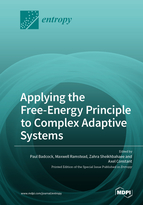Applying the Free-Energy Principle to Complex Adaptive Systems
A special issue of Entropy (ISSN 1099-4300). This special issue belongs to the section "Multidisciplinary Applications".
Deadline for manuscript submissions: closed (31 December 2021) | Viewed by 45234
Special Issue Editors
2. Melbourne School of Psychological Sciences, The University of Melbourne, Melbourne, Australia
3. Orygen, Melbourne, Australia
Interests: theoretical psychology; human evolution and development; mood and affective disorders; youth mental health; active inference; evolutionary systems theory; complex adaptive systems
Interests: active inference; philosophy of psychiatry; cognitive science; ecological cognition; hermeneutics
Special Issues, Collections and Topics in MDPI journals
Interests: physics; machine learning; reinforcement learning; astrophysics and cosmology; free-energy principle; active inference; computational neuroscience; statistics
Interests: computational, evolutionary, and cultural psychiatry; evolutionary computation; human social cognition
Special Issues, Collections and Topics in MDPI journals
Special Issue Information
The free-energy principle is a formulation of the behavior of systems at non-equilibrium steady state that originally gained prominence as a unified model of the brain. Since then, the theory has been applied to a wide range of biological phenomena extending from single-celled organisms and flora, and human culture and niche construction, to the emergence of life and evolutionary dynamics. In a nutshell, the free-energy principle tells us that to exist is to gather evidence for our own existence; it suggests that living systems and their environments become statistical models of each other over time. For organisms, this means actively reducing the uncertainty or entropy of their Bayesian beliefs about what caused their sensory observations, either by changing the statistical models they embody, or by sampling the sensory observations expected under those models. For environments, this means accumulating traces of meaningful, goal-directed activity driven by their denizens. Under this view, living systems (and, implicitly, their environments), are fundamentally in the game of reducing sensory uncertainty and maximizing evidence for their own existence.
It is now widely recognized that the implications of the free-energy principle for our understanding of the human mind and behavior are far-reaching and profound. To date, however, its capacity to extend beyond the human brain, to explain living systems more generally, has only begun to be explored. This begs the question: How far does its explanatory scope extend? Can the free-energy principle be applied to any organism? Does it allow us to explain the dynamics of all living systems, including large-scale social behavior and its effects on local ecologies? Does the free-energy principle provide a formal, empirically tractable theory of any complex adaptive system, living or not?
The aim of this Special Issue is to showcase the breadth of the free-energy principle as a unified theory of biological systems—and to test its limits. Instead of concentrating on the human brain and behavior, we welcome contributions that apply the free-energy principle to other complex adaptive systems, particularly papers that focus on distributed cognitive systems (such as ant colonies, slime molds, and plants) or on self-organization across hierarchically nested spatiotemporal scales.
Dr. Paul Badcock
Dr. Maxwell Ramstead
Dr. Zahra Sheikhbahaee
M.A. M.Sc. Axel Constant
Guest Editors
Manuscript Submission Information
Manuscripts should be submitted online at www.mdpi.com by registering and logging in to this website. Once you are registered, click here to go to the submission form. Manuscripts can be submitted until the deadline. All submissions that pass pre-check are peer-reviewed. Accepted papers will be published continuously in the journal (as soon as accepted) and will be listed together on the special issue website. Research articles, review articles as well as short communications are invited. For planned papers, a title and short abstract (about 100 words) can be sent to the Editorial Office for announcement on this website.
Submitted manuscripts should not have been published previously, nor be under consideration for publication elsewhere (except conference proceedings papers). All manuscripts are thoroughly refereed through a single-blind peer-review process. A guide for authors and other relevant information for submission of manuscripts is available on the Instructions for Authors page. Entropy is an international peer-reviewed open access monthly journal published by MDPI.
Please visit the Instructions for Authors page before submitting a manuscript. The Article Processing Charge (APC) for publication in this open access journal is 2600 CHF (Swiss Francs). Submitted papers should be well formatted and use good English. Authors may use MDPI's English editing service prior to publication or during author revisions.
Keywords
- complex adaptive systems
- entropy
- information
- free-energy principle
- active inference
- living systems








